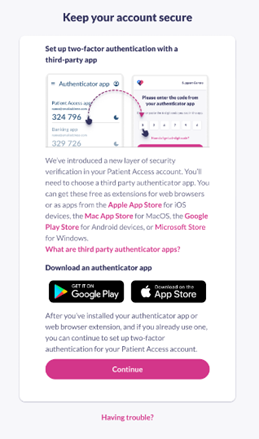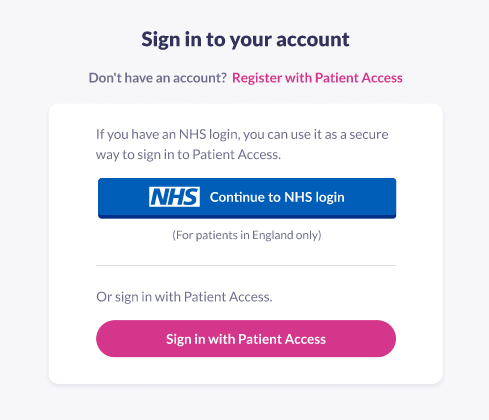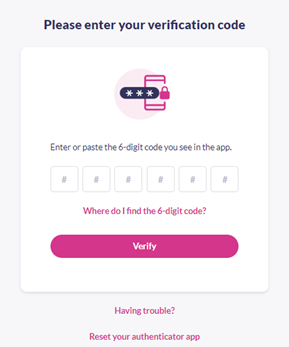Contents
- Introduction
- Installing an authenticator app
- New users registering for a Patient Access account
- Existing Patient Access users with Memorable Word as two-factor authentication
- Existing users with SMS as two-factor authentication
- Sign-in to Patient Access using an authenticator app once configured
- FAQs
Introduction
To ensure the highest level of security, Patient Access will now ask you to enter a 6 digit time-based passcode each time you sign-in, as well as your username and password. To access a passcode, you will need to install an authenticator app.
Note: If you have biometrics (Face ID or Touch ID) enabled, you will not be asked to enter an authentication code each time you sign-in. Alternatively, if you are within England, you can use NHS Login to access your Patient Access account instead.
Installing an authenticator app
You will be prompted to install a third-party authenticator app as part of the process below. This app will provide you with access to the Time-Based One Time Passcode (TOTP) that will be required when signing in to Patient Access in future.
Please note:
- You can use any authenticator app of your choice on your mobile, tablet or desktop device.
- Many authenticator apps are free. The top reviewed apps listed in official app stores, such as the App Store or Google Play, are more likely to be reputable.
- Be aware of 'sponsored' advertised products, which can be listed high up the store.
- Be aware of adverts appearing within other apps (including authenticator apps).
- Do research before installing any additional apps / software to check if it's reputable.
- If an app charges a subscription fee (or offers an itital free trial) you can always choose a different authenticator app.
Some examples of free authenticator apps are listed below:
Android
iOS
Windows
Mac OS
Linux
New users registering for a Patient Access account
- Enter your personal details.
- Click Continue.
- Enter your email address and create a password.
- Accept the Terms and Conditions.
- Click Create account.
- Enter a mobile number (this is optional and you can choose to Skip for now).
- Click Continue.
- Now your account has been created you must verify your email address. An email will be automatically sent to the email address you registered your Patient Access account with. This will provide you with a link to verify your account.
Note: The verification email will expire in 24 hours. If you have not verified your email address within 24 hours, you can click Re-send verification email to send a new link to your email address.
You can click Skip verification for now to verify your email address at a later time. However, please be advised that you can only skip verification for 10 days after this your account will be locked until you have verified your email address - You will be prompted install an Authenticator App on your device. Once you have done so, click Continue.

- Open your third-party authenticator app and either scan the QR code or enter the text code provided in Patient Access.

- Click Next.
- Enter the 6-digit code that appears in your authenticator app.
- Click Verify.

- Your Patient Access account now has two-factor authentication applied using TOTP. When you next sign-in to Patient Access, you will be asked to enter your 6 digit code using your authenticator app.
- Click Done to be directed to your Patient Access dashboard.
Existing Patient Access users with Memorable Word as two-factor authentication
If you have not yet configured SMS authentication or installed an authenticator app, you will be asked to enter your Memorable Word one last time before you are prompted to update this to an authenticator app.
-
Sign-in using your username and password.
Note: If you use NHS Login, you will not be required to install an authenticator app.

-
Enter your Memorable Word for a final time and click Continue.

- You will be prompted install an Authenticator App on your device. Once you have done so, click Continue.

- Open your third-party authenticator app and either scan the QR code or enter the text code provided in Patient Access.

- Click Next.
- Enter the 6-digit code that appears in your authenticator app.

- Click Verify.
- Click Done to be directed to your Patient Access dashboard.

Your Patient Access account now has two-factor authentication applied using TOTP. When you next sign-in to Patient Access, you will be asked to enter your 6 digit code using your authenticator app.
Existing users with SMS as two-factor authentication
SMS authentication will no longer be a valid authentication type. Instead, you will be asked to upgrade this to an authenticator app when you next sign-in.
-
Sign-in using your username and password.
Note: If you use NHS Login, you will not be required to install an authenticator app.

-
Enter your code received via SMS for a final time.

- You will be prompted install an Authenticator App on your device. Once you have done so, click Continue.

- Open your third-party authenticator app and either scan the QR code or enter the text code provided in Patient Access.

- Click Next.
- Enter the 6-digit code that appears in your authenticator app.

- Click Verify.
- Click Done to be directed to your Patient Access dashboard.
Your Patient Access account now has two-factor authentication applied using TOTP. When you next sign-in to Patient Access, you will be asked to enter your 6 digit code using your authenticator app.
Sign-in to Patient Access using an authenticator app once configured
Once you have completed one of the three options above, your subsequent sign-ins will be much quicker.
- Sign-in using your username and password.

- Enter the 6-digit code that appears in your authenticator app.

- Click Verify.
Note: If you have biometrics (Face ID or Touch ID) enabled, you will not be asked to enter an authentication code each time you sign-in. - You will be taken to the Patient Access dashboard.

FAQs
I abandoned the setup process. What should I do if I sign in again?
If you have only completed part of the set up process, you will need to complete this the next time you log in. You will be asked to complete the multi-factor authentication process by downloading an authenticator app and following the steps to link this to your Patient Access account. You will need to make ensure you have entered the 6-digit code when asked, as this competes the set up process.
Note: The code in your authenticator app is time based and will expire. This is usually every 30 seconds for most apps.
If you log in using NHS login, you will be able to access Patient Access without having to download an authenticator app.
I didn't enter the code within the allotted timeframe. What should I do?
Your authenticator app will automatically create a new code once the original one has expired (this is usually every 30 seconds). Once a new code is visible in the app, you'll need to enter this into Patient Access when requested.
Note: We recommend only copying the code when you are ready to enter it as this reduces the risk of it expiring whilst you're in the process of using it.
I entered an invalid code. What should I do next?
Check for the new code generated in your authenticator app and enter it correctly. There's no limit to the number of invalid codes you can enter, but it's recommended to copy and paste the code from the authenticator app to the Patient Access app to avoid inputting it incorrectly.
If you have confirmed that the code you are entering is correct but it still not accepted, you may need to do one of the following:
- Reset the authenticator app
- Uninstall and reinstall the authenticator app
How do I set up the authenticator app?
You can set up the authenticator app by either scanning the QR code provided or manually entering the text code displayed below the QR code in your authenticator app. Any additional instructions will then be available within your authenticator app.
What authenticator app can I use?
You can find various free authenticator apps on Google Play Store, Apple App Store, Mac App Store or Microsoft Store. You do not need to use the paid apps.
What if I don't want to install an authenticator app?
If you're in England, you can use the NHS login option to register/sign in to the Patient Access app without having to install an authenticator app.
Still having a problem?
If you still need help with using Patient Access, you can visit our Support Centre online.
If you want to discuss medical issues, please contact your practice











